When Does Inventory Ownership Occur Under Fob Terms
The ownership of inventory under FOB (“Free On Board”) terms is determined by the specifics of the shipping agreement between the buyer and the seller. FOB terms specify at what point the ownership and responsibility for goods transfer from the seller to the buyer. The terms usually come in two forms: FOB shipping point and FOB destination.
FOB Shipping Point (or FOB Origin)
Under FOB shipping point terms, ownership of the inventory transfers from the seller to the buyer as soon as the goods are shipped. This means that as soon as the inventory is loaded onto a shipping vehicle at the seller’s location, the buyer becomes the owner and is responsible for any costs or risks associated with transporting the inventory to its final destination.
Example: If ABC Electronics sells 100 laptops to XYZ Retail under FOB shipping point terms, XYZ Retail assumes ownership and responsibility for the laptops as soon as they are loaded onto the delivery truck at ABC Electronics’ warehouse.
FOB Destination
Under FOB destination terms, ownership of the inventory remains with the seller until the goods reach their final destination and are available for unloading at the buyer’s location. Only at that point does ownership and responsibility for the inventory transfer from the seller to the buyer.
Example: If DEF Manufacturing sells machinery to GHI Industries under FOB destination terms, DEF Manufacturing retains ownership and is responsible for the machinery until it is safely delivered and available for unloading at GHI Industries’ facility.
Accounting Implications
The FOB terms can have implications for accounting, particularly when dealing with the recognition of revenue, expenses, and inventory on the balance sheet:
- FOB Shipping Point: If you are the buyer, you would account for the inventory and any associated shipping costs as soon as the goods leave the seller’s shipping point. If you are the seller, you would recognize revenue as soon as the goods are shipped.
- FOB Destination: If you are the buyer, you would not account for the inventory until it reaches your location. If you are the seller, you would not recognize the revenue until the goods are delivered to the buyer’s location.
It’s important to clearly understand the FOB terms when entering into a shipping agreement, as it affects not only the ownership but also the accounting treatment of the transaction.
Example of When Does Inventory Ownership Occur Under Fob Terms
Certainly! Let’s consider two different examples for FOB Shipping Point and FOB Destination to illustrate the concept of inventory ownership.
Example 1: FOB Shipping Point
Suppose Company A sells 100 units of a product to Company B for $20 per unit. The terms of the sale are FOB Shipping Point, and the shipping cost is $200.
Accounting Entries for Company A (Seller):
- When the goods are shipped (Ownership transfers to Buyer):
Dr: Accounts Receivable $2,000 (100 units * $20/unit)
Cr: Sales Revenue $2,000
Accounting Entries for Company B (Buyer):
- When the goods are shipped (Ownership transfers from Seller):
Dr: Inventory $2,000 (Cost of goods)
Dr: Inventory $200 (Shipping cost)
Cr: Accounts Payable $2,200
Example 2: FOB Destination
Now, let’s assume Company X sells 50 units of a different product to Company Y for $40 per unit. The terms of the sale are FOB Destination, and Company X incurs $100 in shipping costs to deliver the goods.
Accounting Entries for Company X (Seller):
- When the goods are delivered (Ownership transfers to Buyer):
Dr: Accounts Receivable $2,000 (50 units * $40/unit)
Cr: Sales Revenue $2,000
Shipping Costs:
Dr: Shipping Expense $100
Cr: Cash or Accounts Payable $100
Accounting Entries for Company Y (Buyer):
- When the goods are delivered (Ownership transfers from Seller):
Dr: Inventory $2,000 (Cost of goods)
Cr: Accounts Payable $2,000
In the first example (FOB Shipping Point), Company B (the buyer) takes ownership as soon as the goods are shipped, and they also bear the shipping costs. In the second example (FOB Destination), Company Y (the buyer) only takes ownership when the goods are delivered, and they do not bear the shipping costs—Company X (the seller) does.
The FOB terms significantly influence when the ownership of goods transfers, which in turn affects the accounting entries for both buyers and sellers.













